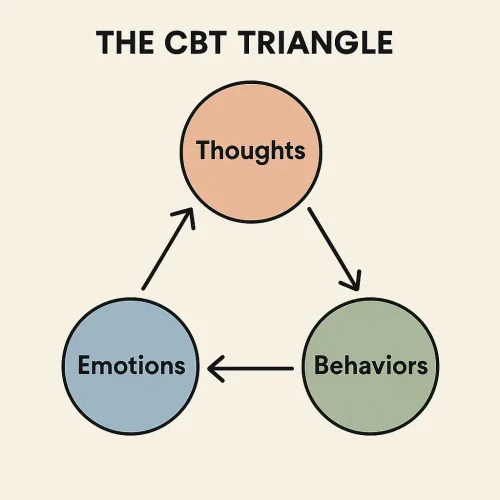Table of Contents
ToggleIntroduction:
Cognitive therapy, or cognitive behavioral therapy (CBT), is a common method in psychotherapy. It looks at how our thoughts, beliefs, and attitudes affect our feelings and actions.
It is based on the idea that changing our thoughts can change how we feel and act. Cognitive therapy helps people find and challenge negative thoughts. These thoughts can lead to anxiety and other mental health problems.
What is cognitive behavioral therapy (CBT)?
Cognitive Therapy from Therapist Aid
Cognitive Behavioral Therapy (CBT) is a well-known and effective type of therapy. It is often used to treat many mental health issues, including anxiety disorders. It combines cognitive techniques, which focus on changing negative thought patterns, with behavioral strategies that target maladaptive behaviors and responses to anxiety triggers.
Here are some key points about CBT and its effectiveness in reducing anxiety symptoms:
- Cognitive Restructuring: CBT helps individuals identify and challenge negative thought patterns and cognitive distortions related to anxiety. By changing their thoughts and replacing irrational beliefs with rational ones, people can gain a more balanced view. This can help reduce anxiety.
- Behavioral Exposure: CBT often includes behavioral exposure techniques, where individuals gradually and safely confront anxiety-provoking situations. By facing their fears often, people can learn that bad outcomes are unlikely. This helps reduce anxiety and avoidance.
- Coping Skills: CBT equips individuals with practical coping skills to manage anxiety more effectively. These skills may include relaxation techniques, deep breathing exercises, problem-solving strategies, and assertiveness training.
- Homework and Skill Building: CBT is a team-based therapy. People are encouraged to practice new skills and coping strategies outside of sessions. This homework reinforces learning and helps individuals integrate these techniques into their daily lives.
- Long-Term Benefits: Studies show that CBT gives quick relief from anxiety symptoms and also has lasting benefits. Individuals who undergo CBT often experience lasting improvements in anxiety management and a reduced risk of relapse.
- Personalized Treatment: CBT is tailored to the individual’s specific needs and goals. Therapists help clients find their unique anxiety triggers. They create a treatment plan that focuses on each person’s specific concerns.
- Versatility: CBT can be applied to various anxiety disorders, including generalized anxiety disorder (GAD), social anxiety disorder, panic disorder, and specific phobias. Its versatility makes it a widely used and effective treatment option for anxiety-related conditions.
In summary, Cognitive Behavioral Therapy (CBT) is a highly effective form of therapy for treating anxiety disorders. CBT combines thinking techniques with behavior strategies.
This helps people create healthier ways to cope and manage their anxiety better. Its evidence-based approach and focus on practical skills make it a helpful tool. It can reduce anxiety symptoms and improve overall mental well-being.
How cognitive therapy helps in overcoming anxiety
Cognitive therapy helps in overcoming anxiety by targeting the underlying thoughts and beliefs that contribute to anxiety symptoms. It teaches individuals to identify and challenge irrational or negative thoughts, replacing them with more realistic and positive ones. By changing how we think about situations that cause anxiety, we can change our feelings and actions toward them.
Cognitive therapy also focuses on teaching individuals practical skills and techniques to manage anxiety symptoms. These may include relaxation exercises, breathing techniques, and problem-solving strategies. By learning and practicing these skills, people can feel more in control of their anxiety. This can help lessen its impact on their daily lives.
Cognitive Therapy from Therapist Aid

The effectiveness of cognitive therapy for anxiety disorders
Cognitive Therapy from Therapist Aid
Numerous studies have demonstrated the effectiveness of cognitive therapy in treating anxiety disorders. Research shows that cognitive therapy can greatly reduce anxiety symptoms.
It can also improve overall functioning in people with different anxiety disorders. These include generalized anxiety disorder, panic disorder, social anxiety disorder, and specific phobias.
A review of several studies found that cognitive therapy works better than no treatment. It is just as effective as other therapies, like medication, for treating anxiety disorders. The long-term benefits of cognitive therapy have also been observed, with individuals experiencing reduced anxiety symptoms even after therapy has ended.
Cognitive therapy techniques for managing anxiety
Cognitive Therapy from Therapist Aid
Cognitive therapy offers a range of effective techniques to help individuals manage anxiety. Two essential techniques are cognitive restructuring and exposure therapy:
- Cognitive Restructuring: This technique focuses on identifying and challenging negative thought patterns, also known as cognitive distortions, that contribute to anxiety. Through cognitive restructuring, individuals learn to replace irrational thoughts with more realistic and balanced thoughts. By doing this, they gain a clearer view of situations that cause anxiety. This can help lessen their anxiety responses.
For example, someone might be afraid of public speaking. They might think, “I will embarrass myself, and everyone will laugh.” Cognitive restructuring would help to challenge this thought. The person can think of more balanced and realistic ideas. For example, “It’s normal to feel nervous before speaking in public. I have prepared well, and I can handle any challenges that come up.”
- Exposure Therapy: Exposure therapy is a behavioral technique that involves gradually and systematically exposing individuals to anxiety-provoking situations. It is conducted in a controlled and supportive environment. By facing these situations many times, people learn that they can handle their anxiety. They also see that their worst fears are less likely to happen.
For example, if someone is afraid of heights, exposure therapy starts with small steps. This could mean looking at pictures of heights. Then, they would slowly move to harder tasks, like standing on a low platform or crossing a bridge. Over time, the individual becomes desensitized to the fear and learns that they can cope effectively with their anxiety.
Both cognitive restructuring and exposure therapy are evidence-based techniques commonly used in cognitive therapy for anxiety disorders. They can be applied independently or in combination, depending on the individual’s specific needs and treatment goals. These techniques help people face their anxiety. They also teach healthier ways to cope. This can lead to less anxiety and better overall well-being.
Finding the right anxiety therapist or counselor
Cognitive Therapy from Therapist Aid
When seeking cognitive therapy for anxiety, it is important to find the right therapist or counselor. Look for professionals who specialize in cognitive therapy or cognitive behavioral therapy and have experience in treating anxiety disorders.
It is important to feel comfortable with your therapist. A good relationship with them will help make therapy more effective.
You can begin by asking your doctor for recommendations. You can also get referrals from trusted friends or family. Additionally, many therapists and counseling centers have online directories where you can search for professionals specializing in anxiety therapy in your area.
Exploring cognitive behavior therapy (CBT) interventions for anxiety
Cognitive Therapy from Therapist Aid
Cognitive behavior therapy (CBT) offers a range of interventions specifically designed to target anxiety symptoms. These interventions may include cognitive restructuring, exposure therapy, relaxation training, and problem-solving skills. Each intervention is tailored to the individual’s specific needs and goals.
Cognitive restructuring involves identifying and challenging negative thoughts and beliefs that contribute to anxiety. With the help of exercises and talks with the therapist, people learn to change irrational thoughts. They replace them with more realistic and positive ones.
Exposure therapy helps individuals gradually and safely confront anxiety-provoking situations. You can do this through imaginal exposure. In this method, people vividly imagine situations that cause anxiety. Another way is in vivo exposure. Here, people slowly face real-life situations that make them anxious.
Relaxation training teaches individuals techniques to reduce physical tension and promote relaxation, such as deep breathing exercises, progressive muscle relaxation, and mindfulness meditation. These techniques can help individuals manage the physical symptoms of anxiety and promote a sense of calm.
Problem-solving skills are taught to help people create good strategies. These strategies help them deal with challenges and reduce anxiety. By learning to solve problems in a clear and organized way, people can feel more in control of their anxiety.
CBT Techniques That Help You Manage Anxiety
Cognitive therapy helps you understand how your thoughts affect your feelings. Let’s look at three powerful CBT tools that support anxiety management.
1. Cognitive Restructuring
This is all about changing the way you think. When you feel anxious, your mind often jumps to the worst-case scenario.
For example: “I made a mistake at work. I’ll probably get fired.” In CBT, a therapist helps you challenge this thought. You learn to ask:
- Is this true?
- What’s the evidence?
- What else could be happening?
You replace fear with facts. This helps calm your mind. Over time, it becomes easier to stop anxiety in its tracks.
2. Exposure Therapy
Avoiding your fears can make anxiety stronger. Exposure therapy helps you face them—step by step. Let’s say you fear public speaking. You might start by:
- Writing a speech
- Practicing it alone
- Reading it to a friend
- Then, speaking in a small group
With support, you slowly build confidence. Your fear starts to fade. CBT uses this method to help you take back control.
Why These Tools Work
When anxiety hits, your body gets tense. Breathing fast. Heart racing. Hard to think straight. CBT includes tools to relax your body and mind. These include:
- Deep breathing exercises
- Progressive muscle relaxation
- Mindfulness techniques
You learn how to calm down in the moment. And you feel stronger when facing anxiety.
Why These Tools Work
Each technique gives you a new way to manage anxiety. Together, they form a powerful system. Cognitive therapy is not just talk. It’s active. It teaches you skills that you use every day. That’s why CBT is one of the most trusted methods for anxiety management.
Want to feel more in control? These tools can help you get there.
Emma’s Journey with Social Anxiety
Emma, a 28-year-old graphic designer, had always been shy. But when her company switched to team meetings over Zoom, her anxiety got worse. She started avoiding calls, fearing she’d say the wrong thing or freeze up in front of her coworkers.
After months of stress, Emma began cognitive therapy. Her therapist used CBT to help her break the cycle of fear.
First, they worked on cognitive restructuring. Emma kept a journal of her anxious thoughts. With her therapist’s help, she challenged ideas like “Everyone thinks I’m awkward” and replaced them with “It’s okay to make mistakes. I’m still learning.”
Then, they used exposure therapy. Emma practiced speaking in low-stress settings—like chatting with friends on video. Gradually, she joined smaller work calls, then larger ones.
She also learned relaxation techniques to calm her nerves before meetings.
After three months, Emma was showing up to every team call. She felt more confident, in control, and connected. For the first time in years, she wasn’t hiding.
Jordan’s Battle with Panic Attacks
Jordan, 35, never knew when his panic attacks would hit. They came out of nowhere—while driving, shopping, even relaxing at home. He felt trapped in his own mind.
He decided to try CBT for anxiety management. In his first session, his therapist explained how cognitive therapy could help him understand and manage his triggers.
Jordan learned about the CBT triangle—how thoughts, emotions, and behaviors are all connected. One trigger was the thought, “Something is wrong with me.” That thought led to fear, which made him feel like he couldn’t breathe.
With cognitive restructuring, Jordan worked to reframe that thought: “This is just anxiety. It will pass.”
His therapist also introduced mindfulness and breathing exercises. Each time a panic attack came on, Jordan focused on slow, deep breaths and grounding techniques.
He kept practicing. Over time, his attacks got shorter and less intense. He started driving again without fear. He even returned to his weekend hikes.
Cognitive therapy interventions for anxiety disorders
Cognitive therapy interventions for anxiety disorders are specifically tailored to address the unique symptoms and challenges associated with each disorder. People with generalized anxiety disorder can find help.
Treatments can focus on reducing excessive worry and the need for control. People with panic disorder may focus on treatments that help with negative thoughts and the fear of panic attacks.
Cognitive therapy helps people change their thinking patterns. It also helps them manage anxiety and improve their quality of life. By looking at the thoughts and beliefs that cause anxiety, people can find lasting relief from their symptoms.
Suggested Products:

The Cognitive Behavioral Workbook for Anxiety: A Step-by-Step Program
- Author: William J. Knaus, EdD
- Why It Helps: Offers structured CBT exercises for overcoming worry, fear, and panic.
- Ideal For: Beginners or anyone wanting guided practice.

Mind Over Mood (2nd Edition)
- Authors: Dennis Greenberger & Christine A. Padesky
- Why It Helps: A proven CBT guide therapists use with worksheets and tools.
- Ideal For: Self-paced learners and therapy companions.

The Anxiety and Phobia Workbook
- Author: Edmund J. Bourne
- Why It Helps: Comprehensive toolkit for dealing with anxiety, panic, and phobias.
- Includes: Breathing techniques, CBT exercises, lifestyle tips.

Positive Psychology Toolkit – Printable CBT Worksheets
Offered By: PositivePsychology.com
Why It Helps: Evidence-based, therapist-approved worksheets for goal setting and thought work.

Weighted Blanket for Anxiety Relief
- Why It Helps: Provides calming pressure, often used in conjunction with CBT.
- Popular Sizes: 12-15 lbs for adults.
Other therapies for anxiety disorders
Cognitive Therapy from Therapist Aid
We have highlighted essential points about the range of effective treatments available for anxiety disorders. Cognitive therapy is a well-known and effective method. However, it’s important to understand that people may respond differently to different types of therapy. Here are some additional considerations:
Psychodynamic Therapy: This form of psychotherapy focuses on exploring unconscious thoughts, emotions, and past experiences that may influence present behaviors and anxiety. Psychodynamic therapy can help individuals gain insight into the root causes of their anxiety and develop healthier coping mechanisms.
Acceptance and Commitment Therapy (ACT) is a type of therapy that uses mindfulness. It helps people accept their anxious thoughts and feelings. Instead of trying to push them away, ACT encourages acceptance. It emphasizes the importance of living in line with one’s values, even in the presence of anxiety. ACT can help people become stronger when dealing with anxiety. It can also lessen the effects on their lives.
Medication: For individuals with severe or chronic anxiety, medication may be prescribed in conjunction with therapy. Antidepressants and anti-anxiety medications can be effective in reducing anxiety symptoms, especially when used in combination with psychotherapy.
Personalized Treatment Plans: Everyone experiences anxiety differently. The best treatment can change from one person to another. A qualified mental health professional can do a detailed assessment. This helps them understand a person’s needs and create a personalized treatment plan.
Seeking Professional Help: Consulting with a qualified mental health professional is essential to determine the most appropriate treatment approach. They can provide expert advice, do a thorough evaluation, and help people look at different therapy options. This way, they can find the best fit for their needs and preferences.
In conclusion, cognitive therapy works well for treating anxiety disorders. However, there are many other therapies and treatments, too. It’s important to get help from a qualified mental health professional. They can help you find the best treatment options for your needs. Using the right therapy with expert help can greatly improve how we manage anxiety and boost our well-being.

Can therapy really help with anxiety?
Cognitive Therapy from Therapist Aid
Yes, therapy can be highly effective in helping individuals manage and overcome anxiety. Cognitive therapy, in particular, has been extensively researched and proven to be an effective treatment for anxiety disorders.
Therapy helps people by focusing on the thoughts and beliefs that cause anxiety. It gives them tools and strategies to manage their anxiety symptoms. This can lead to better overall well-being.
Therapy provides a safe space for people to face their fears. It helps them learn coping skills and understand themselves better.
It gives people a chance to understand their anxiety. They can also learn new ways to think and respond to stressful situations.

CALM MIND Framework
A cognitive therapy-based system for anxiety management.
Online cognitive therapy programs for anxiety
Cognitive Therapy from Therapist Aid
You can find online cognitive therapy programs for anxiety. These programs are available in addition to traditional face-to-face therapy. These programs provide access to evidence-based cognitive therapy techniques and interventions through online platforms. They offer the convenience of accessing therapy from the comfort of your own home and at your own pace.
Online cognitive therapy programs often include interactive modules, educational materials, and guided exercises to help individuals learn and practice cognitive therapy techniques. They may also provide opportunities for online communication with therapists or counselors for additional support and guidance.
It is important to choose a reliable online cognitive therapy program. Make sure it uses proven methods. Look for programs developed by qualified mental health professionals and backed by research studies.
Is CBT Right for You?
1. Do you often find yourself overwhelmed by negative thoughts?
2. Have you experienced persistent anxiety that interferes with daily activities?
3. Are you open to structured, goal-oriented therapy methods?
4. Would you prefer a therapy approach that includes homework and self-reflection exercises?
Conclusion
Cognitive Therapy from Therapist Aid
Cognitive therapy, particularly cognitive behavioral therapy (CBT), is a highly effective approach for managing and overcoming anxiety. By targeting the underlying thoughts and beliefs that contribute to anxiety, individuals can learn to challenge negative thinking patterns and develop healthier coping mechanisms. Cognitive therapy offers many tools, like cognitive restructuring and exposure therapy. These help people manage their anxiety symptoms better.
Finding the right anxiety therapist or counselor is crucial in ensuring the success of cognitive therapy. It is important to seek professionals who specialize in cognitive therapy or cognitive behavioral therapy and have experience in treating anxiety disorders. Additionally, online cognitive therapy programs offer a convenient and accessible option for individuals seeking help with anxiety.
If you are struggling with anxiety, consider reaching out to a therapist or counselor trained in cognitive therapy. With their help, you can find peace of mind and reduce your anxiety. This can lead to a happier and more fulfilling life.
If you or someone you know has anxiety, please contact a qualified mental health professional for help and support.
FAQ:
What is Cognitive Behavioral Therapy (CBT)?
CBT is a structured, goal-oriented type of psychotherapy that helps individuals identify and change negative thought patterns and behaviors. It’s widely used for treating various mental health conditions, including anxiety and depression.
How does CBT help with anxiety management?
CBT assists in managing anxiety by teaching individuals to recognize and challenge distorted thinking patterns. Techniques like cognitive restructuring and exposure therapy help reduce avoidance behaviors and build coping skills.
What can I expect during a CBT session?
In a typical CBT session, you’ll work collaboratively with a therapist to set goals, discuss current challenges, and learn practical strategies to address them. Sessions often include homework assignments to practice new skills between meetings.
How long does CBT treatment usually last?
The duration of CBT varies depending on individual needs, but many people see improvement within 5 to 20 sessions. Some may require longer treatment for more complex issues.
Is CBT effective for all types of anxiety disorders?
CBT is considered highly effective for various anxiety disorders, including generalized anxiety disorder, panic disorder, social anxiety disorder, and specific phobias.
Can CBT be done online?
Yes, CBT can be effectively delivered through online platforms, offering flexibility and accessibility for individuals who prefer remote sessions.
Are there any side effects of CBT?
CBT is generally safe and well-tolerated. However, some individuals may experience temporary discomfort when confronting challenging thoughts or situations during therapy.
How do I find a qualified CBT therapist?
You can find licensed CBT therapists through professional organizations, healthcare providers, or online directories. It’s important to choose a therapist with appropriate credentials and experience in treating anxiety.
What is the role of homework in CBT?
Homework assignments in CBT reinforce the skills learned during sessions. They may include journaling, practicing relaxation techniques, or engaging in exposure exercises to help manage anxiety.
Can CBT be combined with medication?
Yes, CBT can be used alongside medication for anxiety management. Combining therapy with medication may enhance treatment effectiveness, especially for individuals with severe symptoms.
Cognitive Distortion Cheat Sheet
All-or-Nothing Thinking
Description: Seeing things in black-and-white categories with no middle ground.
Example: "If I'm not perfect, I’ve failed completely."
Overgeneralization
Description: Viewing a single event as a never-ending pattern of defeat.
Example: "I always mess things up."
Mental Filter
Description: Focusing solely on the negative detail and ignoring the positive.
Example: "Everyone said it was great, but one person didn’t like it—so it was a failure."
Discounting the Positive
Description: Insisting positive experiences don't count.
Example: "That compliment doesn’t count—they were just being nice."
Jumping to Conclusions
Description: Making negative interpretations without actual evidence.
Example: "He didn’t reply—he must be mad at me."
Catastrophizing
Description: Expecting the worst-case scenario to happen.
Example: "If I fail this test, my life is over."
Emotional Reasoning
Description: Assuming feelings reflect reality.
Example: "I feel guilty, so I must be a bad person."
Should Statements
Description: Criticizing yourself or others with "shoulds" or "musts."
Example: "I should never make mistakes."
Labeling
Description: Attaching a global label to yourself or others based on one incident.
Example: "I'm a loser."
Personalization
Description: Blaming yourself for events outside your control.
Example: "My child failed the test—it must be my fault."
Resourses:
Updated Version: June 10, 2025
Posted: July 20, 2023
Written By: Anna Pereimyvovk
- TherapistAid.com – CBT Worksheets. A go-to site for free, therapist-designed worksheets covering CBT tools and anxiety exercises. Visit Therapist Aid
- Anxiety and Depression Association of America (ADAA). Offers articles, self-help tools, and a therapist directory focused on anxiety disorders.. Visit ADAA
- Mayo Clinic – CBT for Mental Health. A reliable overview of how CBT works and what to expect during sessions.. Read at Mayo Clinic
- The Anxiety and Phobia Workbook by Edmund J. Bourne. A classic, step-by-step guide to understanding and overcoming anxiety with CBT tools. Available on Amazon and other bookstores.
- Mind Over Mood by Dennis Greenberger & Christine A. Padesky. A highly regarded CBT workbook used by therapists and individuals alike. Great for those starting CBT on their own.
- Headspace App – Meditation & Mindfulness. Includes guided meditations and anxiety-reduction techniques rooted in CBT and mindfulness. Visit Headspace
- Calm Clinic – Understanding Anxiety. An educational site breaking down types of anxiety and CBT strategies for each. Visit Calm Clinic
- YouTube Channel: Therapy in a Nutshell. Videos that explain anxiety and CBT in simple terms. Great for visual learners. Watch on YouTube
- National Institute of Mental Health (NIMH). Offers research-backed information on anxiety disorders and treatment methods including CBT. Visit NIMH
- CBT Thought Record Diary App. A mobile app to track anxious thoughts and practice cognitive restructuring in real-time. Available on iOS and Android.
Affiliate Disclosure:
The links contained in this product review may result in a small commission. This goes towards supporting our research and editorial team and please know we only recommend high-quality products.
Note: This article is for informational purposes only and is not intended to diagnose, treat, or cure any disease. Always consult a healthcare professional before taking any supplement or making any changes to your diet or lifestyle.
Printable Thought Records (Therapist Aid Style)
| Situation | Automatic Thought | Emotion | Cognitive Distortion | Reframe | Outcome |
|---|---|---|---|---|---|
| Thought | Evidence For | Evidence Against | Alternative Thought | Outcome |
|---|---|---|---|---|
| Situation | Automatic Thought | Emotion | Cognitive Distortion | Reframe |
|---|---|---|---|---|
| Week's Theme | Reflection Prompts | Thoughts/Feelings | Reframe |
|---|---|---|---|

